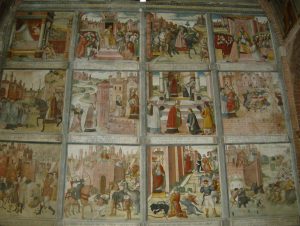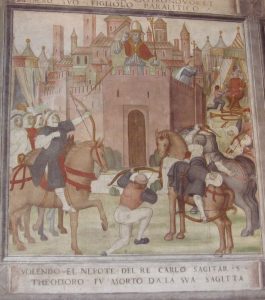Commentary provided by Isabelle Cochelin (University of Toronto).
All medieval textbooks evoke Charlemagne crossing the Alps to come to the rescue of Pope Hadrian I, as he was threatened by “terrible” invaders, the Lombards[1]. The pope was in distress; Charlemagne came to his defense and saved him. In the process, between September 773 and June 774, he besieged and seized Pavia, the capital of the Lombards, and took the title of King of the Lombards. This image is taken from a fresco, painted in 1514 in the church S. Teodoro (also called S. Agnese) of Pavia. The fresco presents a completely different perspective on this well-known story (and distorts a few facts): good Lombards besieged unsuccessfully by violent invaders. Anyone interested in history should enjoy this twist of a well-known tale and different view of Charlemagne.

The fresco tells the story in twelve tableaux of the bishop of Pavia, Teodoro (770-785). His election occupies the first row of four images, two of them illustrating his excellent relationship with the pope (called here Leo IV). The next row of four paintings evokes some of his miracles and closes on the Francesi’s invasion of Pavia, thanks to an act of treason on the Lombard side, and the eventual expulsion of the invaders by Teodoro. The last row is dedicated to the siege of Pavia by the “French”. First, the siege is evoked and it is said that only Teodoro was defending the city. Second, Charlemagne’s nephew tried to kill Teodoro with an arrow that killed him instead (see image below); no name is given to the nephew (nepote), and Charlemagne is simply called Charles (re Carlo). In the penultimate image, shown in the panel to the left here, one observes a quite attractive and physically imposing king Charles in a position of humility and deprivation: kneeling in front of a door of the city, without any visible sign of power, surrounded by his dead soldiers, Charlemagne is praying Teodoro to resurrect his nephew, which the saint does, as is depicted in the background of this same image. The last tableau shows Teodoro able to route out the French, with the help of another miracle.

The lower frieze, below these twelve pictures, tells us that this whole fresco had been offered by some guilds of the city. The years preceding the making of the fresco, the French had attacked the region, controlled it for some time, and then retrieved in 1513. Through the fresco, the Pavians were not only retelling in their own ways a story of the past, but also depicting their present, and expressing their hopes for the future.
[1] On the extremely negative depiction of the Lombards by the papal sources to convince Charlemagne to come down the Alps, see E. Fabbro, “The Charlemagne and the Lombard Kingdom that Was: the Lombard Christian Past in Post-Conquest Italian Historiography,” Journal of the Canadian Historical Association 25/2 (2015): 1–26.